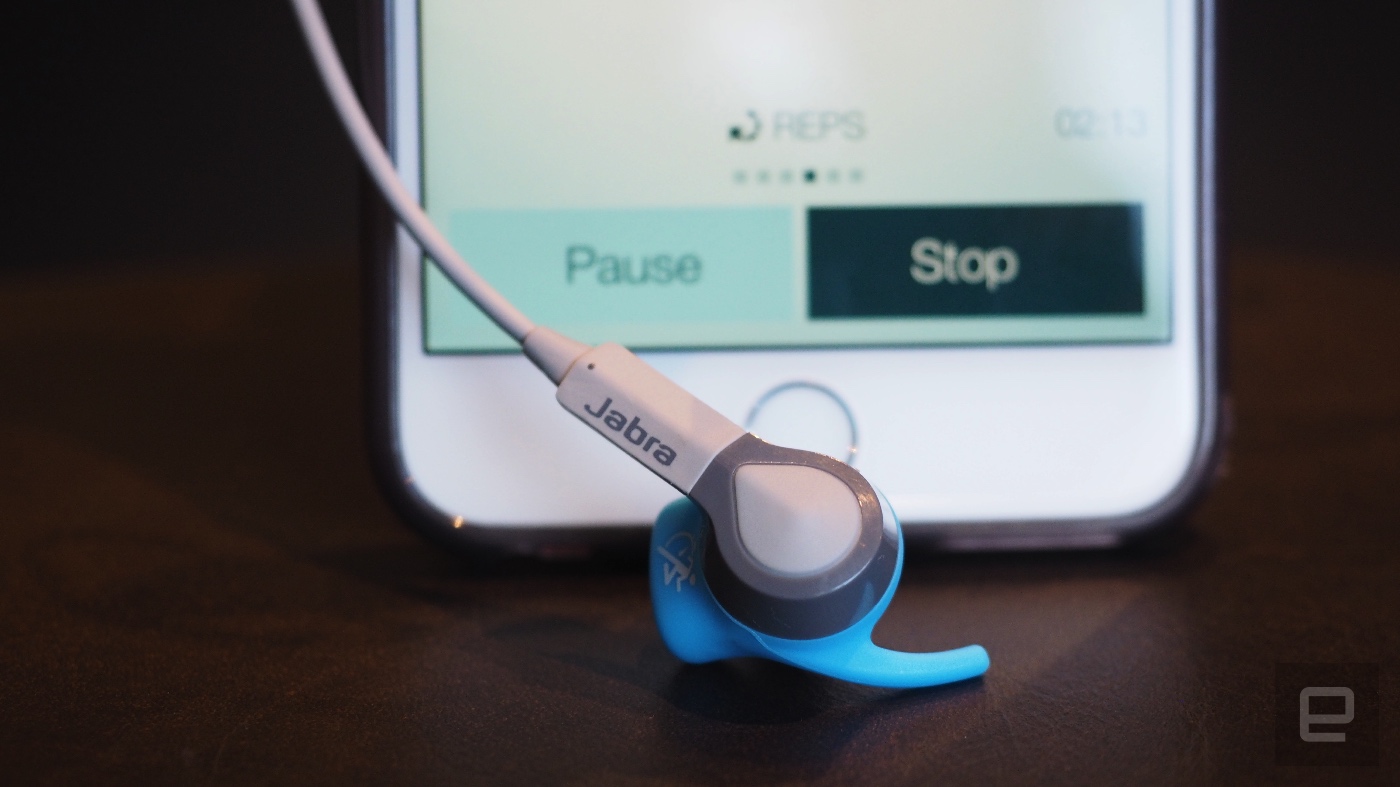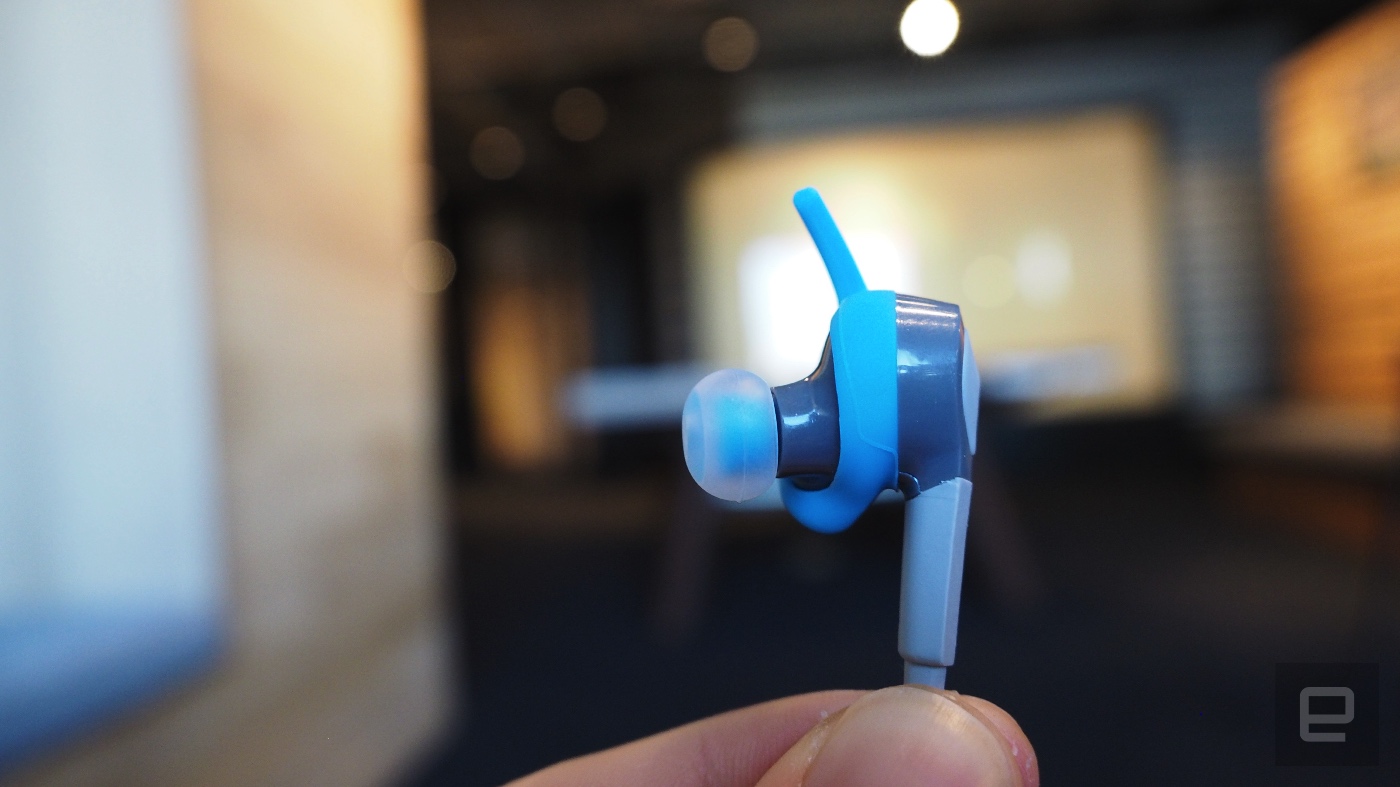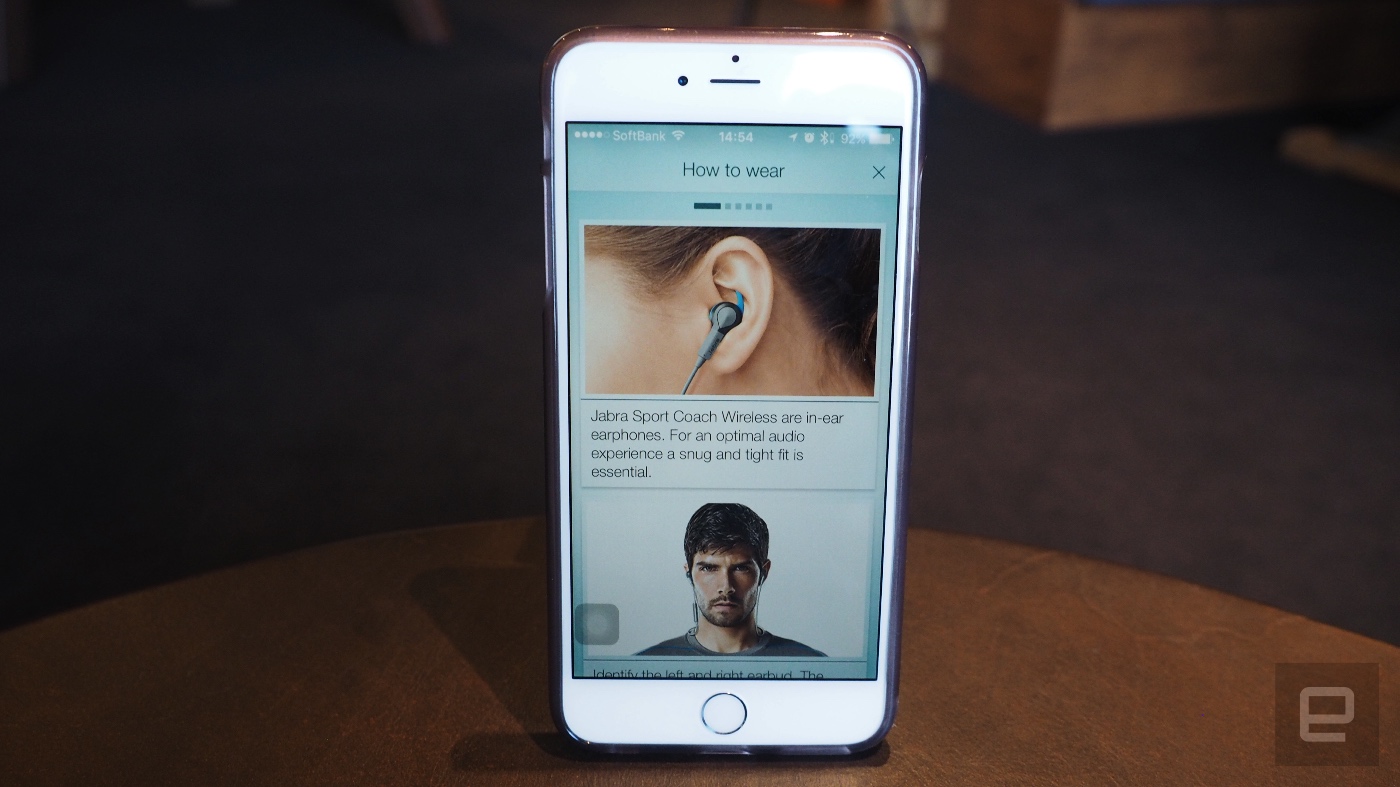
Jabra’s Sports Coach Special Edition ($120) counts your reps through the company’s TrackFit motion sensor embedded in the left ear piece. (You’ll find the micro-USB charging port on the right side.) Your movements are then sent to the companion iOS/Android app. Unlike Jabra’s most recent headphones, these Bluetooth-connected earbuds are still wired together, with an inline remote and a button on the left earpiece to launch the sports app and move between exercises.
As you’d expect from fitness headphones, the Sports Coach Special Editions are IP55-rated for dust and water resistance. As a bonus, they come with a three-year extended warranty for additional peace of mind.
The earphones ship with in-ear tips and gels, in three sizes to ensure they fit most ears. Those gels are soft plastic protrusions that wedge in against the inside of your ear. Thanks to those, the headphones are light, comfortable and secure. I currently use JLab’s Epic2 Bluetooth headphones (as recommended here) for my sweaty music-listening needs.
While the JLab model uses an over-ear hook, I prefer Jabra’s internal solution, which makes it easier to remove while still allowing for a snug fit. The Sports Coach pair also formed a tighter seal on my ear, but your experience may differ.
Of course, sound quality is important, but I find comfort is just as critical with headphones meant for exercise. These feel great and sound just as good as my Epic2s, with the addition of passive noise cancellation. The Sports Coach only comes in one color option, but it’s a reassuringly sporty combination of grey and cyan — pretty inoffensive.
The in-line controller includes a mic for mid-gym phone calls (rude!). Next to that, there are volume controls (a long press will skip tracks) and a multi-function button that pauses music, answers calls and powers the whole thing down. The left earphone also houses a “Sport” button on the side; this launches the companion fitness tracking app on your phone and is also used for progressing and finishing your workout — no need to tap your phone until you’re done. Holding the button will also mute the audio coaching and updates.

The Sports Life app is necessary for all the tracking features though if you’re just looking for comfortable wireless headphones, you can pair the fitness earbuds to your phone and sweat away. Jabra has also ensured that the app plays its coaching narration on top of either iTunes music or any audio source currently playing.
Fortunately, the app is easy to set up. First it shows you how to fit the headphones and uses a sound test to make sure you have the right sized buds. You can then choose the type of exercise you’re planning to do. For automatic repetition counting, the compatible workouts are all found under cross-training, with several of them already programmed, offering a mix of exercises.
You can also make your own, choosing from just under 60 different exercises that are a mix of weight and calisthenic movements. Like the previous-gen version, you can use the headphones to simply track your movement and time your runs. When it comes to running, distance, pace, steps and cadence are all measured by the sensor, but I have glasses for that. And I still hate running.

The rep counter sounded like it was made for me, as I regularly zone out while working out. For me, counting in the midst of push-ups goes something like: “1, 2, 3, 5, 7, 7, 8, 7.” Some kind of robotic unbiased tracking would be pretty useful then. Indeed, for many exercises the rep detection works exactly as promised.
But, not all of my exercises were detected. Push-ups are the worst: While my demonstration made for a great gif, when it came to shooting that clip, the sensor only picked up two reps out of 10. Another time, it detected all of them. The app (or the sensor) is frustratingly erratic. Squats and other exercises requiring vertical head movements are where the earphones works best. You can leave your phone to the side as the audio narration notifies you when you’re done with your rep numbers. One tap of the Sports button on the side moves the app on to your next exercise.
For me, counting in the midst of push-ups goes something like: “1, 2, 3, 5, 7, 7, 8, 7.”
When it does screw up, the headphones are kind enough to tell you it’s not detecting any movement. But that’s often around 10 seconds in, and I’ve already done nine push-ups by then. (Roughly. I zone out, remember?) Conversely, I try to be meticulous in logging what I do at the gym (my current app of choice is Fitocracy), making this mixed performance is just as frustrating as my own estimates.
You’re also stuck with Jabra’s mediocre fitness app, and this is where the system falls short for me. It’s a common drawback with fitness gadgets — they’re typically tied to a specific app built by the same company. You’re buying into their proprietary software, even if you have better options elsewhere.

Although you can custom-build circuits of squats, crunches and what-have-you, automatic rep counting only works for 10 exercises: back extensions, crunches, dips, burpees, kettlebell swings, lunges, pull-ups, push-ups, squats and thrusters. (I had to look up the last one: It’s a combination squat and shoulder press. It looks hard.)
Jabra says that the number of detectable exercises will increase with future updates — but those are the options if you buy the device now. You’re also constrained to that current list of exercises (auto rep-counting or not) if you’re looking to record your full workout… and it’s not an exhaustive list. This is because Jabra’s headphones can only detect movements related to your head and due to that, there’s a limit as to how much a gadget can track when it comes to weight training. I guess one solution is to move the tracker into the weights themselves — but then, I’d still need a pair of headphones.



